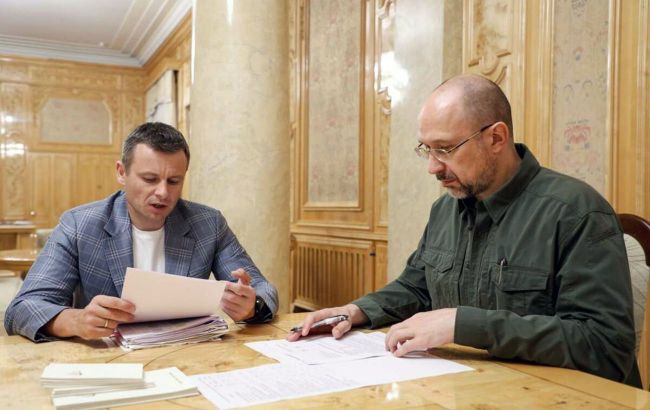Ukraine's economic outlook for 2024: Western loans or money printing
 Prime Minister and Minister of Finance of Ukraine Denys Shmyhal and Serhii Marchenko (photo: t.me/Denys_Smyhal)
Prime Minister and Minister of Finance of Ukraine Denys Shmyhal and Serhii Marchenko (photo: t.me/Denys_Smyhal)
What scenarios can Ukraine's economy develop under in 2024 and the main risks it faces - read below in the RBC-Ukraine article.
The material was prepared based on information from open sources, the Memorandum of Cooperation between Ukraine and the IMF, and exclusive comments from experts.
Ukraine managed to live through 2023 without any serious financial and economic shocks. There were no significant fluctuations in the foreign exchange market due to the fixed hryvnia exchange rate. GDP growth may exceed 5% at the end of the year, and this will be driven mainly by a good harvest. The inflation rate will decline significantly - last year, price growth exceeded 26%, while this year, according to all forecasts, inflation will remain within 5-6% - in November, its annual rate was 5.1%.
The economy in 2023, after falling by 29% in 2022, began to recover thanks to much less infrastructure damage and rhythmic financial support from international partners. The Ukrainian budget, which needs $42 billion in foreign aid, has received only $3.3 billion from the United States. However, this amount may come to the budget as early as 2024.
The intensity of hostilities and the dynamics of external financial flows from the main partners - the IMF, the EU, and the US - will be the main risks to the economy next year. These factors will determine the scenario of economic development - positive, basic, or negative.
The IMF, in its Memorandum of Understanding updated after the second revision of the program, defined the baseline scenario as one in which active war will last until the end of 2024. During the preparation of the loan program in March 2023, the IMF assumed that the war would end in mid-2024, but in the latest revision, it postponed the deadline by six months.
"Economic growth in 2023 was stronger than projected, and we expect it to continue in 2024, albeit at a somewhat slower pace," the IMF says.
Economic activity in Ukraine in 2023 was more resilient than expected as businesses adapted to the war, the memorandum says. "Economic activity recovered strongly in the first half of 2023, and activity indicators in the third quarter of 2023 point to sustained growth as supply chains improved, production expanded, and economic activity picked up (including due to the defense industry, construction, and a bumper harvest)," the memorandum says.
The labor market has shown signs of stabilization, giving reason to expect a decline in unemployment. In 2022, it was 24.5%, and in 2023 - 19.1%. The figure is expected to drop to 13.9% next year, and 2027 will be just over 10%. The economic growth rate in 2023 should lay the foundation for further recovery in 2024 at 3-5%, the document says.
There are no particular concerns about inflation. In 2023, price growth was moderate, even after the increase in electricity tariffs for households by almost 60%. "Given the persistence of inflationary trends and the impact of the National Bank of Ukraine's monetary policy, we expect inflation to be around 6% year-on-year by the end of 2023 and slightly below 10% year-on-year by the end of 2024," the memorandum says. But this can only happen if the war ends by the end of 2024.
 President of Ukraine Volodymyr Zelenskyy and IMF Managing Director Kristalina Georgieva (photo: Getty Images)
President of Ukraine Volodymyr Zelenskyy and IMF Managing Director Kristalina Georgieva (photo: Getty Images)
Positive scenario
Ukraine's economy can recover faster, but only if security risks are reduced. This will facilitate the faster return of migrants and revive economic activity. In addition, logistical difficulties, particularly with maritime transportation, will be reduced.
The Ukrainian government is also confident that in the medium term, European integration processes will have a positive impact on economic recovery. "In the medium term, our economic growth can be accelerated through the decisive implementation of structural reforms in the context of EU integration, significant investments in recovery, including private investment," the memorandum says. However, the investment forecast is still rather modest. After falling by almost $14 billion in 2022, an inflow of $3 billion is expected in 2023 and $2.3 billion in 2024.
This scenario is considered only theoretically, as no one has yet provided any forecasts for an improvement in the economic situation.
Baseline scenario
The Center for Economic Strategy (CES) predicts lower GDP growth in 2024 than in 2023 and higher inflation. Vitalii Vavryshchuk, Head of Macroeconomic Research at Investment Capital Ukraine Group, makes a similar forecast: GDP growth will decline from 5.8% in 2023 to 5% in 2024. Inflation will rise from 6.2% to 10.1%. These figures are close to those contained in the memorandum with the IMF and the forecasts of the government and the National Bank. However, the NBU is more pessimistic about GDP, forecasting growth of 3.6%.
CES Executive Director Hlib Vyshlinskyi explains the deterioration in economic growth expectations by the fact that the economy has already adapted to the war, and there will probably be no new major "breakthroughs" shortly. In addition, external financing in 2024 may decline compared to 2023.
"The economy will always be under the influence of extremely high risks, both military and logistical, as it was in 2023, when both the positive risk of opening Odesa ports and the negative risk of the blockade of the Polish border were realized," he says in a commentary to RBC-Ukraine.
A more accurate forecast, he believes, will be possible at the end of January, when the situation with funding from the EU and the US becomes clearer. "If the financing is incomplete concerning the needs, the real GDP growth will be lower, and prices will rise. But in general, the situation in the economy will reflect the picture on the battlefield - neither victory nor defeat," the expert emphasizes.
Despite the war, Ukraine's economy surprised in 2023 with fairly good performance, but next year, the risks will increase, so the result will be worse, Vitalii Vavryshchuk is sure. "We expect many new challenges to emerge in 2024, perhaps the biggest of which are the risks associated with the volume and sustainability of external financial support for Ukraine," he says.
However, according to Mr. Vavryshchuk, the risks of a significant reduction in funding are low. "We expect that Ukraine will receive at least 28-30 billion dollars (41 billion is needed - ed.). This is the amount of support needed to balance external accounts by the end of 2024," he says.
Under these conditions, the NBU will be able to fully control the foreign exchange market and continue its liberalization, Vavryshchuk said. "There are also all the necessary preconditions for a moderate and controlled devaluation of the hryvnia, and, according to our forecasts, the exchange rate at the end of 2024 will be about 41 UAH/USD," the ICU expert says.
If these risks do not materialize, the economy will continue to grow. Inflation will be less than 7% at least until the summer and will accelerate by the end of the year, Vavryshchuk believes. The cycle of monetary policy easing is almost complete, but symbolic cuts to the NBU's key policy rate are possible in the second half of 2024 if inflation and currency risks remain balanced. In addition, in 2024, Ukraine is due to restructure its external debt again, which was postponed for two years in July 2022.
"The terms of the restructuring will largely depend on assumptions about the duration of the war and the sustainability of international financial assistance," Vavryshchuk says.
 Hryvnia printing (photo: NBU)
Hryvnia printing (photo: NBU)
Negative scenario
A negative scenario could develop in the event of a protracted war. The IMF is considering the end of 2025. In addition, blockades of export transit routes, damage to energy infrastructure, and disruptions in supply chains may continue. All this will increase production costs and reduce the profitability of enterprises. In addition, this scenario is likely to slow down the return of internally displaced persons to Ukraine.
Economic forecasts under this scenario will also be much worse. GDP could fall by 5% in 2024, and in 2025 it would be zero. Defense spending will remain quite high, increasing the budget deficit and the need to finance it by 2027, amounting to $140 billion. The main financial burden will fall in 2024, when "unconventional taxation measures" must be used to increase budget revenues and cut spending.
In case of unforeseen circumstances, the income tax may be increased. In addition, an additional tax on luxury goods may be introduced, and the excise tax system may be revised. In addition, currency regulation may be tightened, and a fixed hryvnia exchange rate may be reintroduced. And in case of urgent need, the NBU may resort to issuing bonds. "We will apply for equity financing from the NBU only as a last resort and in strictly limited amounts," the memorandum signed by the country's top officials says.
"Attracting more than $40 billion in foreign loans and grants is still not guaranteed, so the risk of money printing (buying government bonds) by the National Bank will exist next year," Vavryshchuk says.
Today, it is almost impossible to estimate the probability of military risks. However, the risks associated with the rhythm of financing are gradually becoming apparent. The regular money flow to the budget is primarily needed to ensure monthly social payments. However, the issue of financial support for Ukraine's budget from the United States is unlikely to be resolved by the end of 2023. The decision to provide funds from the EU is also being postponed. If the European Commission manages to reach an agreement with Hungary, which is blocking the approval of the EU budget, the decision may be made in January. If the alternative option of providing financial assistance from the 26 EU countries individually is used, it will take some time, possibly until March. This is the timeframe mentioned by Ukraine's Vice Prime Minister Olha Stefanyshyna. At the same time, according to the latest information, the EU summit to approve the allocation of 50 billion euros of aid to Ukraine will be held on February 1.
Thus, Ukraine is likely to face a shortage of money in the first quarter of 2024. The next year's budget has already minimized the costs of recovery. If the inflow of external money decreases, Ukraine will have to save money and keep spending on some programs to cover priority expenses, including social payments.

